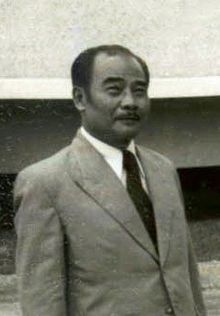Souphanouvong
Souphanouvong | |
|---|---|
ສຸພານຸວົງ | |
 | |
| 1st President of Laos | |
| In office 2 December 1975 – 29 October 1986 | |
| Prime Minister | Kaysone Phomvihane |
| Preceded by | Office Established; Sisavang Vatthana (as King of Laos) |
| Succeeded by | Phoumi Vongvichit (Acting) |
| President of the of the Supreme People's Assembly | |
| In office 2 December 1975 – 31 October 1986 | |
| Preceded by | Office Established |
| Succeeded by | Sisomphon Lovansay (acting) |
| Personal details | |
| Born | 13 July 1909 Luang Phrabang, Laos |
| Died | 9 January 1995 (aged 85) Vientiane, Laos |
| Political party | Lao People's Revolutionary Party |
| Spouse(s) | |
Prince Souphanouvong (Lao: ສຸພານຸວົງ; 13 July 1909 – 9 January 1995) was, along with his half-brother Prince Souvanna Phouma and Prince Boun Oum of Champasak, one of the "Three Princes" who represented respectively the communist (pro-Vietnam), neutralist and royalist political factions in Laos. He was the figurehead President of Laos from December 1975 to August 1991.
Souphanouvong was one of the sons of Prince Bounkhong, the last viceroy of Luang Prabang. Unlike his half-brothers, Souvanna Phouma and Phetsarath Ratanavongsa, whose mothers were of royal birth, his mother was a commoner, .
Educated in France and Vietnam,[1] he eventually became a supporter of Ho Chi Minh and joined the Indochinese communist movement. In August 1950, Souphanouvong convened the first congress of the (Neo Lao Issara), more generally known as the Pathet Lao, which served as the vehicle for the communist challenge to French rule. He was the chairman of the Neo Lao Issara (since 1956, Neo Lao Hak Xat) and Resistance Government.
He participated in the coalition governments with royalists in 1957, 1962 and 1973.[1]
He was elected President of National Assembly from 1958 to 1959 following the success in the 1958 elections.[1]
Nicknamed "The Red Prince", he became part of the Lao People's Revolutionary Party. Upon its successful seizure of power in 1975, he became the first President of the Lao People's Democratic Republic, a position which he held until 1991.[2] After 1986, Phoumi Vongvichit acted in his stead as president, though Souphanouvong still technically remained President. Kaysone Phomvihane succeeded him as president in 1991. He was the President of the Supreme People's Assembly from 1975 to 1988.[3]
In 1991, he became an Adviser of Party's Central Committee. Souphanouvong died aged 86 a few years later,[4] and was buried in a stupa next to the Pha That Luang.
Souphanouvong spoke eight languages, including Greek and Latin.[citation needed] He worked in the ports of Le Havre before studying for an engineering degree from the École nationale des ponts et chaussées.
His son, Khamsay Souphanouvong, escaped the country and applied for political asylum in New Zealand in 2000.[citation needed]
In 2012, Souphanouvong's remains were moved to the newly constructed National Cemetery in Vientiane.
Honours and Awards[]
 Soviet Union:
Soviet Union:
 Bulgaria: Grand Cross of the Order of Stara Planina
Bulgaria: Grand Cross of the Order of Stara Planina Cuba:
Cuba:
 Mongolia: Grand Cross of the Order of Sukhbaatar
Mongolia: Grand Cross of the Order of Sukhbaatar Vietnam: Order of Ho Chi Minh
Vietnam: Order of Ho Chi Minh Czechoslovakia: Order of Klement Gottwald
Czechoslovakia: Order of Klement Gottwald
References[]
- ^ Jump up to: a b c Stuart-Fox, Martin. "Historical Dictionary of Laos". epdf.pub. ISBN 978-0-8108-5624-0.
- ^ Souphanouvong, Prince. The Columbia Encyclopedia, 6th ed.. Columbia University Press
- ^ Speakers
- ^ Souphanouvong, "red prince'' of Laos, dies aged 86. Hartford-hwp.com (1995-01-12). Retrieved on 2013-11-17.
External links[]
- 1909 births
- 1995 deaths
- Lao People's Revolutionary Party politicians
- Communist rulers
- Laotian royalty
- People from Luang Prabang
- Presidents of the National Assembly (Laos)
- People of the Vietnam War
- Presidents of Laos
- Members of the 1st Central Committee of the Lao People's Party
- Members of the 2nd Central Committee of the Lao People's Revolutionary Party
- Members of the 3rd Central Committee of the Lao People's Revolutionary Party
- Members of the 4th Central Committee of the Lao People's Revolutionary Party
- Members of the 2nd Politburo of the Lao People's Revolutionary Party
- Members of the 3rd Politburo of the Lao People's Revolutionary Party
- Members of the 4th Politburo of the Lao People's Revolutionary Party